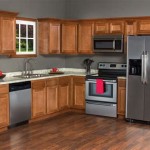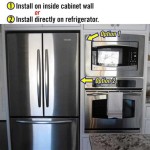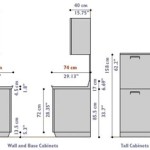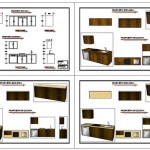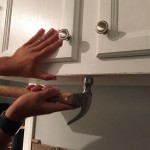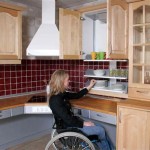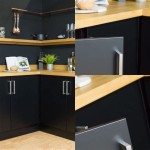Ways To Refinish Old Kitchen Cabinets
Kitchen cabinets contribute significantly to a kitchen's overall aesthetic and functionality. Over time, cabinets can show wear and tear, diminishing their appeal. Refinishing offers a cost-effective way to revitalize these essential components without the expense of full replacement. Several methods exist for refinishing kitchen cabinets, each with its own set of advantages and disadvantages.
1. Painting: Painting is a popular choice for refinishing due to its relative simplicity and wide range of color options. The process involves thorough cleaning, sanding to create a smooth surface for adhesion, priming, and finally, applying the chosen paint. Multiple coats may be required for optimal coverage and durability. Options include oil-based paints, known for their durability and smooth finish, and latex-based paints, which offer easier cleanup and lower VOC emissions.
2. Staining: Staining allows the natural wood grain to show through while adding color and enhancing the wood's inherent beauty. This method is best suited for solid wood cabinets. The process typically involves stripping any existing finish, sanding the wood to a smooth surface, applying the stain, and sealing with a protective topcoat. Gel stains offer thicker coverage, making them suitable for cabinets with imperfections, while penetrating stains provide a more natural, translucent finish.
3. Refacing: Refacing involves replacing the cabinet doors and drawer fronts while applying a new veneer to the existing cabinet boxes. This offers a significant visual upgrade without the demolition involved in a full cabinet replacement. The new veneer can match the new doors and drawer fronts, creating a cohesive and updated look. Refacing is a more complex process than painting or staining but less disruptive than a complete remodel.
4. Glazing: Glazing adds a decorative, antique or distressed look to cabinets. It's a technique that involves applying a translucent colored glaze over a base coat, then wiping it off to leave color in the crevices and details of the cabinet doors. This highlights the architectural features of the cabinetry. Glazing can be used over painted or stained surfaces, adding depth and character.
5. Lacquering: Lacquering provides a high-gloss, durable finish often associated with high-end cabinetry. It involves applying multiple thin coats of lacquer, which creates a hard, smooth surface resistant to scratches and moisture. Lacquering requires specialized equipment and expertise due to the quick-drying nature of lacquer and the potential for imperfections in the finish if not applied correctly. This method is often best left to professionals.
Preparation for Refinishing: Regardless of the chosen method, thorough preparation is crucial for successful cabinet refinishing. This includes removing cabinet hardware, thoroughly cleaning the surfaces to remove grease and grime, and sanding to create a smooth surface for the new finish to adhere to. Proper preparation ensures a professional-looking and long-lasting result.
Choosing the Right Method: Selecting the appropriate refinishing method depends on several factors. These factors include the existing cabinet material, the desired aesthetic, budget, and DIY experience. Solid wood cabinets offer greater flexibility, suitable for staining, painting, or glazing. Laminate cabinets, on the other hand, typically require painting or refacing. The complexity of certain techniques, such as lacquering, may necessitate professional assistance.
Materials and Tools: Each refinishing method requires specific materials and tools. Painting requires brushes, rollers, paint trays, primer, and the chosen paint. Staining requires sandpaper, stain applicators, wood conditioner, stain, and a topcoat. Refacing necessitates specialized tools for veneer application. Researching the necessary materials for the chosen method ensures adequate preparation.
Cost Considerations: Refinishing offers a significant cost advantage over replacing cabinets. Painting is generally the most budget-friendly option, followed by staining. Refacing falls in the mid-range, while lacquering and custom finishes are at the higher end of the cost spectrum. Budget considerations play a significant role in determining the most suitable refinishing method.
Environmental Considerations: When selecting materials, consider the environmental impact. Low-VOC paints and stains minimize the release of harmful volatile organic compounds. Proper disposal of old finishes and cleaning materials is also essential for environmental responsibility. Opting for eco-friendly products contributes to a healthier home environment.
Maintenance and Care: Once cabinets are refinished, proper maintenance helps preserve their renewed appearance. Regular cleaning with gentle cleaners prevents buildup of grease and grime. Avoiding abrasive cleaners and harsh chemicals helps maintain the finish's integrity. Promptly addressing spills prevents staining and damage. Proper care ensures the longevity of the refinished cabinets.
Refinishing Kitchen Cabinets A Beautiful Mess

Cabinet Refinishing Guide

How To Refinish Cabinets Like A Pro

Refinishing Kitchen Cabinets Modern Refacing Made Easy Wisewood

How To Refinish Kitchen Cabinets Diy

How To Refinish Kitchen Cabinets N Hance

Avoid These Mistakes How To Paint Cabinets That Are Already Painted Grace In My Space

The Easy Way To Refinish Kitchen Cabinets

How To Paint Kitchen Cabinets Like The Pros

How To Refinish Wood Kitchen Cabinets
Related Posts

